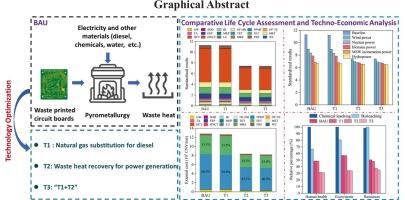电子废物回收:综合生命周期评估和技术经济分析揭示了火法冶金的优势,并提供了回收废弃印刷电路板的优化框架。
IF 7.1
2区 环境科学与生态学
Q1 ENGINEERING, ENVIRONMENTAL
引用次数: 0
摘要
随着电子垃圾以每年3% - 5%的速度增长,金属可以回收利用。火法冶金虽然可以有效地从废弃印刷电路板(wpcb)中回收粗铜,但在减轻环境影响和经济可行性方面面临重大挑战。本研究基于中国一家企业的第一手工业数据,实施了生命周期评估(LCA)和技术经济分析(TEA),比较了当前火法冶金(BAU)、三种优化技术(T1:天然气替代柴油、T2:余热回收发电、T3:“T1 + T2”综合优化)和湿法冶金的环境经济绩效和政策适应性。结果显示,由于中国对燃煤电网的依赖,高耗电量主导了火法冶金的环境热点,在所有中点和终点指标中,耗电量占31.84% - 64.25%,占31.85% - 49.86%。而T1达到本文章由计算机程序翻译,如有差异,请以英文原文为准。

E-waste recycling: Integrated life cycle assessment and techno-economic analysis unravels pyrometallurgy’s edge and delivers an optimization framework for recovering waste printed circuit boards
With electronic waste growing at 3 %–5 % annually, metals can be recycled. Pyrometallurgy, while effective for recovering crude copper from waste printed circuit boards (WPCBs), faces significant challenges in environmental impact mitigation and economic feasibility. This study implemented life cycle assessment (LCA) and techno-economic analysis (TEA) based on first-hand industrial data from an enterprise in China to compare environmental-economic performance and policy adaptability across present pyrometallurgy (BAU), three optimized technologies (T1: Natural gas substitution for diesel, T2: Waste heat recovery for power generation, T3: Integrated optimization of “T1 + T2”) and hydrometallurgy. It was revealed that significant electricity consumption dominated the environmental hotspots in pyrometallurgy due to China’s reliance on coal-fired power grids, contributing 31.84 %–64.25 % and 31.85 %–49.86 % across all midpoint and endpoint indicators. While T1 achieved <5 % per-ton environmental gains, its emission reduction benefits became notable at 3614 tons/year. T2 reduced environmental burdens by 7.18 %–51.58 % through waste heat-to-energy conversion that cut electricity demand. Furthermore, T3 achieved optimal performance in 17 midpoint indicators and three endpoint categories, reducing environmental impact by 7.26 %–51.73 % and 30.22 %–40.46 %, respectively. From techno-economic perspective, T3 delivered the highest economic feasibility with a payback period of 4.69 years and remained viable under stricter environmental taxes or corporate tax hikes. Sensitivity analysis revealed that grid decarbonization could reduce environmental burden of traditional pyrometallurgy by 20.44 %–40.92 %, highlighting the synergistic necessity of energy transition and process optimization. This study provides a technical selection framework and policy insights for green recycling of WPCBs, advancing circular economy and dual carbon goals.
求助全文
通过发布文献求助,成功后即可免费获取论文全文。
去求助
来源期刊

Waste management
环境科学-工程:环境
CiteScore
15.60
自引率
6.20%
发文量
492
审稿时长
39 days
期刊介绍:
Waste Management is devoted to the presentation and discussion of information on solid wastes,it covers the entire lifecycle of solid. wastes.
Scope:
Addresses solid wastes in both industrialized and economically developing countries
Covers various types of solid wastes, including:
Municipal (e.g., residential, institutional, commercial, light industrial)
Agricultural
Special (e.g., C and D, healthcare, household hazardous wastes, sewage sludge)
 求助内容:
求助内容: 应助结果提醒方式:
应助结果提醒方式:


